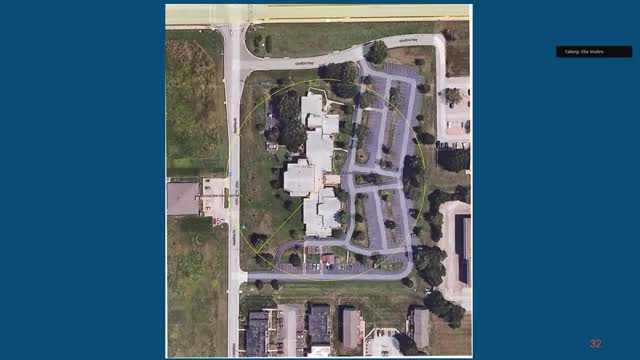Tensions Rise Over Historic Designation and Development Plans
July 19, 2024 | Lawrence, Douglas County, Kansas

This article was created by AI summarizing key points discussed. AI makes mistakes, so for full details and context, please refer to the video of the full meeting. Please report any errors so we can fix them. Report an error »

In a recent meeting of the Historic Resources Commission (HRC), significant discussions emerged regarding the architectural context surrounding the First Presbyterian Church of Lawrence and its implications for nearby properties, particularly Park 25 apartments. The meeting highlighted the ongoing tensions between the church, local developers, and the city, stemming from concerns over potential developments west of Crestline Drive.
Key points raised included the classification of three non-historic sheds on the church property, which staff determined do not contribute to the architectural significance of the church. The sheds, located at the rear of the property, were deemed not to impact views or the overall design of the primary structure. This assessment led to a recommendation against extending the context area beyond the sheds, as it would impose unnecessary architectural review standards on neighboring properties.
Marisa Peterson, a representative of Park 25 apartments, expressed her concerns about being drawn into contentious issues due to ongoing litigation involving the church and the city. She emphasized the long-standing commitment of Park 25 to the community and urged the HRC to recommend a context area that would protect the church's historicity without adversely affecting its neighbors.
James Kessinger, attorney for Park 25, further articulated the potential negative consequences of a broader context area. He argued that defining the landmark as the church's architectural features, rather than extending the context to include surrounding properties, would prevent unintended administrative burdens on Park 25 and other nearby developments.
Greg Musil, representing Iowa Street Partners, echoed these sentiments, highlighting the need for a compromise that would protect the church while allowing neighboring properties to operate without excessive restrictions. He pointed out that the existing protections for the church under state and federal designations should suffice, and that extending the context area could lead to ongoing friction within the community.
The discussions underscored the complexities of balancing historic preservation with the needs of local businesses and developers, as stakeholders seek a resolution that respects the architectural significance of the church while fostering a collaborative community environment. The HRC is expected to consider these perspectives as they move forward with their recommendations to the city commission.
Key points raised included the classification of three non-historic sheds on the church property, which staff determined do not contribute to the architectural significance of the church. The sheds, located at the rear of the property, were deemed not to impact views or the overall design of the primary structure. This assessment led to a recommendation against extending the context area beyond the sheds, as it would impose unnecessary architectural review standards on neighboring properties.
Marisa Peterson, a representative of Park 25 apartments, expressed her concerns about being drawn into contentious issues due to ongoing litigation involving the church and the city. She emphasized the long-standing commitment of Park 25 to the community and urged the HRC to recommend a context area that would protect the church's historicity without adversely affecting its neighbors.
James Kessinger, attorney for Park 25, further articulated the potential negative consequences of a broader context area. He argued that defining the landmark as the church's architectural features, rather than extending the context to include surrounding properties, would prevent unintended administrative burdens on Park 25 and other nearby developments.
Greg Musil, representing Iowa Street Partners, echoed these sentiments, highlighting the need for a compromise that would protect the church while allowing neighboring properties to operate without excessive restrictions. He pointed out that the existing protections for the church under state and federal designations should suffice, and that extending the context area could lead to ongoing friction within the community.
The discussions underscored the complexities of balancing historic preservation with the needs of local businesses and developers, as stakeholders seek a resolution that respects the architectural significance of the church while fostering a collaborative community environment. The HRC is expected to consider these perspectives as they move forward with their recommendations to the city commission.
View full meeting
This article is based on a recent meeting—watch the full video and explore the complete transcript for deeper insights into the discussion.
View full meeting
